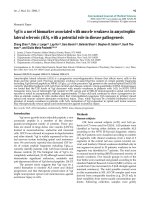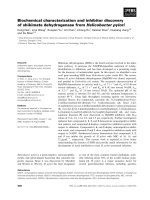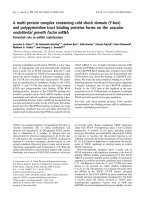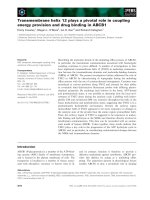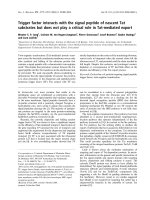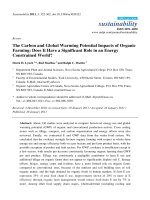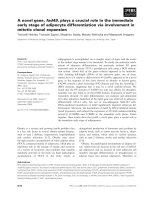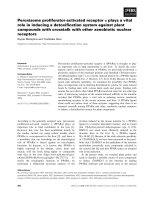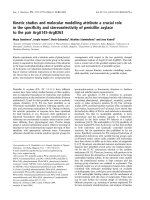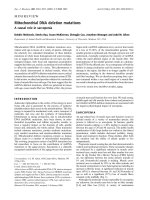A novel protein from helicobacter pylori with a potential role in gastroduodenal diseases
Bạn đang xem bản rút gọn của tài liệu. Xem và tải ngay bản đầy đủ của tài liệu tại đây (1.45 MB, 103 trang )
Introduction
1.1 Helicobacter pylori and gastroduodenal diseases
Helicobacter pylori is a gram-negative, spiral-shaped microaerophilic bacterium that
colonizes the human gastric mucosa. Since the successful isolation of H. pylori by
Marshall and Warren in 1983, doors have been opened for scientists to study the
association of H. pylori with various gastroduodenal diseases. Persistent colonization of
H. pylori in human gastrointestinal tracts has been closely linked to gastric diseases
ranging from gastritis, non-ulcer dyspepsia and peptic ulcer to the increased risks of
gastric cancer (Buck et al., 1986; Dunn et al., 1997). Being a major human gastric
pathogen, H. pylori infects more than half of the world’s population and has been causing
gastric diseases worldwide (Blaser et al., 1994; Uemura et al., 2001).
For the past two decades, great effort has been focused on the study of H. pylori
with respect to its bacteriology, physiology, genetics, pathogenesis and epidemiology of
infection (Rothenbacher & Brenner, 2003). Treatment of peptic ulcer disease has been
developed (Graham et al., 1992). However, current therapies remain to be improved as
the organism is perfectly adapted to the ecological niche in the gastric mucosa and
currently available antibiotics are not specifically designed to be active in the stomach
(Sherwood et al., 2002; Schreiber et al., 2004).
1.2 Characteristics of H. pylori
Two morphological forms were observed in H. pylori: spiral and coccoid (Hua &
Ho, 1996). The spiral-shaped H. pylori is the active form capable of colonization and
infection (Dunn et al., 1997). On the other hand, the coccoid form is considered as viable
but non-culturable (Van et al., 1994) and has been considered as the resting state of the
1
Introduction
bacterium (Benaissa et al., 1996). Under unfavorable conditions such as depletion of
nutrients, addition of antibiotics or stress stimuli (low pH or high temperature),
morphological conversion from spiral to coccoid can be observed in in vivo culture
(Catrenich & Makin, 1991). However, the resuscitation from coccoid to spiral has not
been reported in in vitro conditions. Therefore, controversies remain among researchers
as some regarded coccoids as dead bacterial cells (Kusters et al., 1997; Enroth et al.,
1999) while others believed that coccoids are viable but non-culturable (Hua & Ho, 1996;
Zheng et al., 1999; Saito et al., 2003).
The spiral form of H. pylori expresses a great number of proteins that participate in
various bacterial metabolic activities such as cell survival and proliferation, adhesion,
colonization and transportation of macromolecules. In contrast, the coccoid expresses
significantly less proteins related to the basic metabolism such as cell respiration,
maintaining cellular integrity and DNA synthesis (Kusters et al., 1997; Narikawa et al.,
1997; Costa et al., 1999). It is widely agreed that the spiral form is mainly responsible for
the pathogenesis of H. pylori infection (Dubois, 1995). In contrast, it has been suggested
that the dormant coccoid form may be involved in the transmission of H. pylori infection
(Hua & Ho, 1996; Zheng et al., 1999; Andersen et al., 2000; Ng et al., 2003).
1.3 Pathogenesis of H. pylori
Several proteins have been identified in H. pylori to be associated with its virulence
and pathogenesis. The most intensively studied virulence factors are cytotoxin-associated
immuno-dorminant protein (CagA), vacuolating toxin A (VacA), adhesins, flagella,
urease and heat shock proteins (HSPs). These factors act independently from each other
2
Introduction
in the course of H. pylori infection but are indispensable for bacterial pathogenesis (Prinz
et al., 2003).
Among the various virulence factors, adhesins are important for mediating receptor-
ligand recognition in the initial interaction between H. pylori and host. Many H. pylori
proteins have been identified as adhesins specific for interaction with particular ligands of
the host (Aspholm et al., 2004). These include blood-group-antigen-binding adhesion
(BabA) which is an adhesin of H. pylori interacting with the blood group antigen-Lewis
antigen on gastric epithelial cells (Ilver et al., 1998; Hennig et al., 2004); Sialic acid-
binding adhesion (SabA) that is responsible for the binding of H. pylori to sialyl-Lewis x
antigens in gastric epithelium in humans (Mahadavi et al., 2002); OipA (outer
inflammatory protein) and HopZ (homologue of porin) which are associated with the
adhesion and colonization of H. pylori in vitro and in vivo, respectively (Yamaoka et al.,
2002).
The sheathed flagellum is responsible for the motility of H. pylori which is
necessary for bacterial survival in the viscous mucus layer (Josenhans et al., 1995) while
surface localized urease is an enzyme served to maintain a neutral pH microenvironment
for the survival of H. pylori in the acidic stomach (Eaton et al., 1991; Perez-Perez et al.,
1992; Clyne et al., 1995). CagA and VacA have been proven to be two major virulence
factors of H. pylori, of which CagA protein can be translocated into the epithelial cells to
trigger a cascade of signal transduction pathways (Segal et al., 1999; Hirata et al., 2004)
while VacA is known for its ability to induce cytoplasmic vacuole formation in various
eukaryotic cells (Telford et al., 1994; Cover et al., 2005). HSP is another group of
3
Introduction
virulence factor essential for maintaining the normal functions of other H. pylori proteins
and assisting its survival in the stomach (Kamiya et al., 1998).
1.4 Interaction between H. pylori and gastric mucus layer
The human stomach is protected by the gastric acid of a pH around 2.0 while a
viscous layer of mucus acts as the protective barrier for the underlying gastric epithelium
(Vinall et al., 2002). The main component of the mucus is a high molecular weight
glycoprotein known as mucin, which has a long linear structure consisting of subunits
joined by disulfide bonds (Thomsson et al., 2002). The subunit of mucin contains a
peptide core that is interspersed among clusters of oligosaccharide side chains (Stanley et
al., 1983; Karlsson et al., 1996). The diversity of mucin oligosaccharides has been found
to provide multiple receptors for bacterial lectins of invading pathogens (Karlsson et al.,
1989 & 1995). Furthermore, experimental evidence has illustrated that the adherence to
mucin occurs in a number of pathogens such as Pseudomonas aeruginosa, Candida
albicans and Staphylococcus aureus
(Hoffman et al., 1993; Bruce et al., 1995; Shuter et
al., 1996). In the case of H. pylori, it is
believed that attachment to the mucus layer has
been established between the bacteria and host before its colonization at the epithelium
and specific adhesins could exist in mediating such interaction (Linden et al., 2002).
Kalpana (2003) described a protein from H. pylori that has the ability of binding to mucin
in in vitro assays which has been identified to be a hypothetical protein of H. pylori
coded as HP0049 in the genome of H. pylori ATCC 26695 (Tombs et al., 1997). It is
therefore interesting to characterize the functions of this novel protein and explore its
possible role in the pathogenesis of H. pylori related gastroduodenal diseases.
4
Introduction
1.5 Objectives of study
This study aims to characterize this hypothetical protein HP0049 and examine its
functions in H. pylori. The main goals of the project are to clone and express the gene
encoding HP0049 followed by characterization of the recombinant protein. In the process,
the recombinant protein will be employed to raise specific antibody, which will be used
for sub-cellular localization of the protein in H. pylori by transmission electron
microscopy (TEM). Biochemical and physiological studies will be carried out to explore
the probable role of the hypothetical protein HP0049 in H. pylori pathogenesis.
5
Survey of Literature
2.1 Characteristics of H. pylori
2.1.1 Isolation and culturing of H. pylori
Research in H. pylori began in earnest after its isolation in 1983 by Marshall and
Warren. Helicobacters belong to a new genus of bacteria, mainly inhabiting along the
interface of mucosa and gastric epithelial cells of mammals. H. pylori NCTC 11637 is the
type species of the genus, Helicobacter. It is gram-negative, microaerophilic, spiral-
shaped, flagellated and urease positive bacterium. It is a nutritionally fastidious
microorganism which is able to form about 1 mm transparent colonies on enriched agar
plates supplemented with 5-10% horse blood after 3-5 days of incubation (Goodwin &
Worsley, 1993). H. pylori is also an oxygen sensitive bacterium that strictly grows in the
presence of 5-10% carbon dioxide at 35-37˚C under humidified conditions (Goodwin et
al., 1986). The organism can proliferate in both non-selective and selective media
supplemented with antibiotics (Goodwin & Worsley, 1993; Westblom et al., 1991)
whereby the latter are widely used for the isolation of H. pylori from biopsy samples.
H. pylori can be cultured on solid agar plates as well as in liquid media. However,
the growth of H. pylori in liquid media (generally enriched with yeast extract and serum)
is comparatively slower than that on the agar plate. Nevertheless, broth culture has been
used favourably in the study of its metabolic activities and and physiological properties
(Goodwin et al., 1986; Ho & Vijayakumari, 1993). H. pylori has been shown to grow in
brain heart infusion (BHI) broth supplemented with 0.4 % yeast extract and 10% horse
serum under microaerophilic conditions in an efficient and continuous culture system (Ho
& Vijayakumari, 1993).
6
Survey of Literature
2.1.2 Morphological features of H. pylori
Based on electron microscopy studies, two major morphological forms of the
bacteria were observed: spiral and coccoid. In an early study by Benaissa et al. (1996),
the conversion from spiral to coccoid via U-shaped transition form was clearly observed
under transmission electron microscopy. Thereafter, similar observations of
morphological conversion were reported by other researchers in later studies (Kusters et
al., 1997; Costa et al., 1999). The spiral shaped H. pylori is approximately 0.5 µm in
width and 2-3 µm in length, equipped with 4-6 unipolar-sheathed flagella that are
continuous with the outer cell membrane (Wang et al., 2006). It is believed that the spiral
shape of the bacteria and corkscrew movement provided by the sheathed flagella have
enabled the organism to penetrate the viscous gastric mucus layer (Ottemann &
Lowenthal, 2002). The ultra thin sections of H. pylori under electron microscopy also
exhibited the typical cell wall structure of gram-negative bacterium that consists of both
outer and inner membrane, with condensed cytoplasm containing nucleoid material and
ribosome (Costa et al., 1999).
On the other hand, the round shaped coccoid forms of H. pylori are more or less
regarded as degenerative and dead cells (Kuster et al., 1997). There is another group of
researchers who suggested that the coccoid form is viable but non-culturable (Hua & Ho,
1996; Saito et al., 2003). Substantial variation in cell wall structure, surface protein
profiles and DNA contents were detected during the transition from spiral to coccoid
(Benaissa et al., 1996; Costa et al., 1999), which hints that the two differential forms of H.
pylori could contribute different roles during infection.
7
Survey of Literature
2.1.3 Genetics of H. pylori
The complete genome of H. pylori strain 26695 was reported by Tomb et al in 1997.
It contains 1,667,867 base pairs of nucleotides and 1,590 predicted coding regions. A
second complete genome of strain j99 was published in 1999 (Alm et al). Comparison of
the two genomes revealed higher than 97% homology between them at the gene size and
gene order with a limited number of discrete regions that are organized differently. When
viewed in a genome wide manner, about 6-7% of the annotated genes are strain specific
and are absent from each other with no homologue in the database (Alm et al., 1999).
The prevalence of H. pylori infection varies in different geographical regions,
ethnic backgrounds, socioeconomic conditions and age groups (Covacci et al., 1999),
possibly contributed by the diversified bacterial genotypes of the isolates (Yamazaki et
al., 2005). Unusual heterogeneity has been observed among the genotypes of clinical
isolates and bacterial populations within the infected hosts, and the variation in bacterial
population can be observed in individuals infected with more than one H. pylori strain
(Blaser, 1990). The evolution of genotypic diversity in H. pylori may have been resulted
from the presence of multiple strains within the same host, as plural cohabitation tends to
favor the occurrence of free intraspecies recombination.
2.2 Virulence factors of H. pylori
2.2.1 Adhesins of H. pylori
Many adhesins have been identified or predicted by the annotation of ORFs (open
reading frames) in the H. pylori genome (Tomb et al., 1997; Alms et al., 1999). Most of
them are outer membrane proteins that mediate receptor-ligand interaction between
8
Survey of Literature
bacteria and host escorting the adhesion of H. pylori onto the mucus layer (Doig et al.,
1992). Blood group A antigen-binding adhesin (BabA) is one such adhesin that has been
extensively studied. BabA is encoded by allelic babA2 gene and is involved in the
binding of bacteria to the blood group antigen Lewis b surface epitopes of host (Boren et
al., 1993; Ilver et al., 1998). Another newly identified adhesin is SabA (Sialic acid-
binding adhesion) for binding to sialyl-Lewis x antigens in gastric epithelium in humans
(Mahadavi et al., 2002). The adherence of H. pylori to sialylated glycoconjugates
expressed during chronic inflammation contributes to the virulence and the extraordinary
chronicity of H. pylori infection (Mahadavi et al., 2002).
The other H. pylori proteins reported to be involved in the adherence of H. pylori
onto the gastric epithelium are OipA (outer inflammatory protein, HP0638) (Yamaoka et
al., 2002) and HopZ (homologue of porin) (Peck et al., 1999). It was noted that different
numbers of CT dinucleotide repeats are characteristically present in the sequences of
these adhesion genes (oipA, hopZ and sabA), which determine the functional status of
these genes. In addition, it was also reported that the inclusion of the CT nucleotide
repeats in the open reading frame would turn on the expression of these genes whereas
the deletion and substitution of those repeats would cease the expression of these genes
(Yamaoka et al., 2002). Interestingly, the functional status (on/off) of oipA, hopZ and
sabA were found to affect the adherence and colonization properties of H. pylori
(Yamaoka et al., 2002).
9
Survey of Literature
2.2.2 Other pathogenic factors of H. pylori
A number of H. pylori proteins have been established as virulence factors involved
in its infection of the gastric mucosa. Among these factors, two major groups were
classified as either related to adhesion and colonization of H. pylori or causing damage to
host cells and benefiting the survival of bacteria in vivo.
Among the bacterial proteins that have been reported to be crucial for the adhesion
and colonization of H. pylori include flagellins that are responsible for bacterial motility
(Josenhans et al., 1995; Ottemann & Lowenthal, 2002) and urease that neutralizes the
acidic pH (Dunn et al., 1990; Tsuda et al., 1994; Karita et al., 1995). There are also
various catalases and oxidases (Harris et al., 2003) that are enzymes leading to different
biochemical degradations. Others include outer membrane proteins with or without
known functions (Yamaoka et al., 2002), phospholipase (Dorrell et al., 1999) and
numerous adhesins that mediate the adhesion of H. pylori to different host ligands.
Mutations in the genes coding for these adhesive proteins in H. pylori have been found to
reduce the adherence capability or colonization ability of the bacteria onto the gastric
mucosa in animals (Evans et al., 2000).
The other major group of virulence factors that causes tissue damage include
vacuolating cytotoxinA (VacA) and cag pathogenicity island (cagPAI) which have been
shown to be related to peptic ulcer and associated with the induction of immune response
of the host (Le’Negrate et al., 2001). In addition, recent studies indicate that heat shock
proteins e.g. HSP60 are necessary for the bacteria in combating against the hostile
environment (Spohn et al., 2002).
10
Survey of Literature
Findings on H. pylori virulence factors showed that the bacteria possess a group of
unique features essential for its successful colonization in the host. Adherence to the
gastric mucus layer protects the organism against the hostile acidic environment in the
stomach and thereby allows the bacteria to penetrate and establish persistent colonization
on the gastric epithelium. During the course of its infection, H. pylori induces various
levels of immune responses in the host which further develop into different types of
gastroduodenal diseases.
2.3 H. pylori infection and gastroduodenal diseases
It is reported that more than 50% of the world’s population is infected with H. pylori
(Blaser, 1990) and the prevalence of H. pylori infection varies in different regions, races
and age groups. Significant difference in the incidence of H. pylori infection has been
noticed between developing and developed countries, with a level as high as 70-90% and
as low as 20-40%, respectively (Bardhan, 1997). In multi-ethnic Singapore, the infection
rates of H. pylori in Chinese and Indian populations are 2.5 times higher than that in the
Malays (Epidemiol News Bull, 1996), suggesting the possible effect of racial differences
in and host genetic predisposition to H. pylori infection.
A prospective study from infancy to adulthood demonstrated that H. pylori infection
could be detected at an early stage of life at the age of 10 (Malaty et al., 2002). The
finding indicates that the acquisition of H. pylori may occur in childhood by vertical
transmission through intrafamilial route (e.g. from parents to children, or grand parents to
grand children). This has also been supported by reports of several other studies (Taneike
et al., 2001; Ng et al., 2003; Roma-Giannikou et al., 2003).
11
Survey of Literature
H. pylori infection is closely associated with the induction of various gastroduodenal
diseases including gastritis, non-ulcer dyspepsia, gastric ulcer, duodenal ulcer as well as
gastric cancer. About 90% of chronic gastritis is caused by H. pylori (Sobala et al., 1991).
The association of non-ulcer dyspepsia (NUD) with H. pylori has been debated among
researchers (Pieramico et al., 1993). Recent reports showed that dyspeptic symptoms
concurred with the infection of certain virulent H. pylori strains (Treiber et al., 2004). H.
pylori remains the main etiological agent of peptic ulcer including gastric ulcer (GU) and
duodenal ulcer (DU) (Mauch et al., 1993; Moss & Calam, 1993) while the eradication of
H. pylori enhances the healing process of a bleeding peptic ulcer (Arkkila et al., 2003).
More interestingly, prevalence of H. pylori increases in gastric cancer patients (De Koster
et al., 1994). Hence, it is essential to study H. pylori and its pathogenesis as it could
undoubtedly improve the understanding of these related gastroduodenal diseases and
refine their current treatments.
2.4 Gastric mucosa and mucin
The human gastrointestinal tract is covered by a viscous and continuous layer of
mucus, which acts as a protective barrier for the underlying mucosa (Gendler & Spicer,
1995). The main component of mucus is a high molecular weight glycoprotein (mucin)
(Natomi et al., 1993). Interactions between bacterial pathogens and mucins derived from
human and animal species have been studied intensively. In the case of H. pylori, it is
most frequently found within and beneath the gastric mucous layer as well as attached to
the surface of gastric epithelial cell (Hazell et al., 1992; Falk et al., 1993; Olfat et al.,
2002). The organism is found in the duodenum only at sites of gastric metaplasia (Wyatt
12
Survey of Literature
et al., 1990) and is also discovered in colonizing patches of heterotropic gastric mucosa at
the upper esophagus (Borham et al., 1993), suggesting a specific tropism of the organism
for gastric mucosal surfaces in humans. It is noted that few organisms exhibit such a strict
tissue tropism, which makes the adherence properties of H. pylori to mucus layer
particularly interesting to examine.
It has been reported that H. pylori possesses a fibrillar hemagglutinin that
recognizes sialic acid containing structures on erythrocytes and on mouse adrenal cells
(Evans et al., 1988 & 1989). What has also been found is that mucins of different origin
such as porcine gastric mucin, bovine submaxillary mucin and human salivary mucin are
able to inhibit H. pylori hemagglutination activity (Nakazawa et al., 1989; Piotrowski et
al., 1991). These observations indicate the likely existence of particular H. pylori proteins
which could interact with sialic acid terminated molecules present on gastric epithelial
cells as well as in the gastric mucus layer.
The role of interaction between H. pylori and the gastric mucin in its pathogenesis is
yet to be established. As has been suggested by other studies on bacterial attachment to
mucin such as E. coli (Helander et al., 1997; Katayama et al., 1997), the attachment of H.
pylori to gastric mucin might facilitate dissemination of the organism in the stomach
mucus layer and allow subsequent colonization on the underlying epithelium to occur.
It is believed that the specific characteristics of mucins are affected by invading
microorganisms. Human gastric mucin appears to be altered in patients with certain
disease such as gastritis or peptic ulcer (Younan et al., 1982). In addition, it is reported by
Hashiguchi (1993) that H. pylori can enzymatically degrade mucin by specific protease
called mucinase thus alter its physicochemical properties. Therefore, a detailed study on
13
Survey of Literature
the interaction of H. pylori with several gastric mucin types will be useful for elucidating
the mechanism of adhesion.
H. pylori colonizes the gastric mucosa following its adherence and penetration of
the mucus layer covering the gastric epithelium (Hessey et al., 1990; Dunn et al., 1991).
Colonization of the gastric mucus layer protects the bacteria from extreme acidity of the
gastric tract and displacement from the stomach by forces such as those generated by
peristalsis and gastric emptying. The clinical significance of the host-pathogen
interactions that allow the attachment of H. pylori to human gastric cells remains to be
fully elucidated (Marshall, 1993). It is considered unlikely that chronic infection with H.
pylori could occur in the absence of sophisticated adhesin-host cell interaction.
2.5 Mucin binding proteins (MBPs) in bacteria
Interaction of H. pylori with gastric mucin is not an isolated case (Mantle et al., 1989;
Lillehoj et al., 2004). A number of bacteria colonizing the mucosa can be found in the
mucus layer and adhere to the epithelial cells (Blomberg et al., 1993; Yoshiyama &
Nakazawa, 2000). Over the recent decade, several studies on the adhesion of lactobacilli
to epithelial cells and mucus have been reported (Rojas & Conway, 1996; Kirjavainen et
al., 1999; Edelman et al., 2002) showing that most lactobacilli used in probiotic products
adhere to human intestinal mucus. In most cases, adhesion has been reported to be
mediated by proteins like collagen binding protein (CnBP) of Lactobacillus reuteri (Roos
& Jonsson, 2002). The binding activity of this protein is blocked by porcine intestinal
mucin and by a lectin with specificity for α-D-galactose, suggesting CnBP adheres to
mucin via a lectin-like interaction. Roos & Jonsson (2002) characterized the adhesion of
14
Survey of Literature
Lactobacillus reuteri to intestinal mucus components in vitro. Their results show that a
high molecular weight protein possessing the typical features of cell surface protein from
gram positive bacteria could adhere to components of mucus. However, in the case of
Pseudomonas aeruginosa, it has been shown previously that the adhesion of the bacteria
to human respiratory mucins might be mediated by pilus and alginate but recently the
observation of the binding of non-pilated mutants to mucins and glycolipids suggested
the existence of a type of non-pilus adhesion (Nelson et al., 1990; Ramphal et al., 1991;
Plotwoski et al., 2001). In order to characterize the adhesion, Carnoy et al (1994)
examined the interaction of the outer membrane proteins from two adhesive P.
aeruginosa strains with two types of glycoproteins secreted in human respiratory mucus,
which are mucin and lactotransferrin. Several adhesins in both strains were identified.
Non-typeable Haemophilus influenzae strains are the most common pathogens
encountered in patients with chronic bronchitis. These organisms chronically colonize the
airways of patients and occasionally bind to mucus. Quantitative studies of such adhesion
were reported by Vogel et al (1994), who developed a reproducible micro titer plate
assay to study mucin binding and found that 1hour of incubation is the most optimal for
binding assay. The assay method has thus been established as a useful method for
studying bacteria-mucin interaction in vitro and a large number of bacterial proteins have
been reported possessing different levels of affinity with mucins of various origins.
2.6 Family of peptidyl-arginine deiminase (PAD)
Peptidylarginine deiminase (PAD) is a family of enzymes that catalyze the
conversion of protein-bound arginine to citrulline.
In mammalian cells, the enzyme is
15
Survey of Literature
mainly involved in post-translational modification of proteins that could have a big
impact on the structure and function of the target protein (Nissinen et al., 2003). Four
highly conserved isoforms of PAD enzymes have been identified in a wide range of
mammalian tissues (Terakawa et al., 1991). Both the enzymes and their products have
been widely studied with the knowledge that their close association with several human
diseases such as rheumatoid arthritis (RA) and multiple sclerosis (MS) have been
reported (Pritzker et al., 2000).
To date, the only prokaryotic PAD that has been purified is from bacterium
Porphyromonas gingivalis which has been associated with the initiation and progression
of adult-onset periodontitis. It can convert both peptidyl-arginine and free L-arginine into
citrulline and produce ammonia concurrently in the presence of Calcium ions (McGraw
et al., 1999) and is believed to be a virulence factor of the organism by preventing acidic
cleansing cycles of the mouth.
PADs in prokaryotic cells have been proven to be evolutionarily unrelated to
mammalian PADs as the two share low DNA sequence homology and possess different
sets of conserved enzymatic domains although catalyzing the same reaction. However,
they are more closely linked with other prokaryotic enzymes such as arginine deiminase
and amidinotransferase by adopting a common fold and similar catalytic mechanisms
(Shirai et al., 2001).
16
Survey of Literature
2.7 Techniques used in protein functional studies
2.7.1 Western ligand blotting analysis
Western blot technique using labeled probes has been used widely to identify
potential protein receptors in bacteria by several investigators. In 1998, a convenient
method for the detection of carbohydrate-binding activity of lectins was established by
Kamemura & Kato. The method was mainly a combination of blotting of lectins onto
polyvinylidene-difluoride membranes, labeling by conjugated biotinylated probes and
horseradish peroxidase-streptavidin followed by detection using enhanced
chemiluminescence of enzyme reaction. Using Western blot analysis, Calabi et al (2002)
identified two potential ligands of the Clostridium difficile surface layer proteins (SLP).
Mongodin et al (2002) investigated fibronectin binding protein (FnBPs) in
Staphylococcus aureus by Western ligand affinity blotting analysis. Downer et al (2002)
used elastin as a ligand in Western blotting to identify elastin binding protein in S. aureus
(EbpS). By affinity chromatography and Western blotting assays, Plotkowski et al (2001)
showed the interaction of different Pseudomonas aeruginosa outer-membrane proteins
(OMPs) with heparin. In the light of the effectiveness of this method, Western blot
analysis was also employed for identifying the binding affinity of H. pylori proteins with
biotin-labeled mucins in this study.
2.7.2 Solid phase carbohydrate binding assay
Solid phase binding assay has served efficiently in identifying and screening the
proteins of interest in many bacteria (Kemeney & Challacomb, 1988). In this method, the
ligand is usually coated on solid phase micro titer plates and probe is added in order to
17
Survey of Literature
examine any possible interaction between the two. Liang et al (1995) studied vitronectin-
binding activity in different fractions of Staphylococcus aureus using micro titer plates
with immobilized human vitronectin. Van de Wetering et al (2001) used a solid phase
based binding assay to specify that Lipoteichoic acid (LTA) of Bacillus subtilis bound by
surfactant protein D (SP-D) instead of A (SP-A), of which both SP-D and SP-A have
been reported to be important for mediating binding of various gram-negative bacteria
that cause pneumonia. The binding of uropathogenic Escherichia coli to host cells is
mediated at the tips of pili by the peptidoglycan (PepG) adhesin, which recognizes the
alpha (1-4) Gal disaccharide on the uroepithelial surface. This phenomenon was
demonstrated by Mahmood et al (2000) using a specific solid phase assay. In many other
studies of proteins and their ligands, solid phase assay is also successfully employed in
combination with western blot analysis for characterizing the mechanism of interaction.
2.7.3 Immuno-gold labeled transmission electron microscopy (TEM) and
protein localization
With the development of antibody techniques and electron microscopy, immuno-
labeled electron microscopy has become an effective tool in displaying the ultra-
structural location of molecules in cells and tissues. It is widely used in studying the
localization of proteins in eukaryotes and prokaryotes (Herrera, 1992). Immuno-labeled
transmission electron microscopy (TEM) is the most commonly used technique for
visualizing the exact location of molecules in cells. Protein A-gold conjugates are
generally utilized as probes for immuno-staining as the gold particles can be readily
spotted under electron microscopy (EM).
18
Survey of Literature
Immuno-gold labeled TEM has long been used in the studies of protein localization
in H. pylori. In 1990, Hawtin et al used the monoclonal antibodies of urease to image the
localization of urease in H. pylori. Later, Drouet et al (1991) demonstrated the surface
localization of a 19kDa outer membrane protein and polysaccharides of H. pylori. The
localization of various proteins in H. pylori have been determined by different
researchers using immuno-gold labeled TEM techniques and the method has been
credited as a powerful tool in studying the localization of H. pylori proteins (Du & Ho,
2003), which excitingly provides important information on the understanding the
functions of these proteins in the bacteria.
19
Materials and Methods
3.1 Culturing of H. pylori
Stock culture of H. pylori NCTC11637 was inoculated onto chocolate blood agar
plate consisting of blood agar base (Oxoid) with 5% horse blood. The plates were then
incubated at 37°C in a humidified incubator (Forma Scientific) with 5% CO
2
for three
days.
3.2 Cloning of mbp (mucin binding protein) gene
3.2.1 Chromosomal DNA extraction
Genomic DNA of H. pylori NCTC11637 was extracted according to the method
described by Hua et al (1999). Plate cultures of H. pylori were harvested and transferred
to Eppendorf tubes containing 1.5 ml TE buffer (pH 8.0). The suspension was then
centrifuged at 8000 xg for 5 minutes at room temperature and washed once with TE
buffer. An aliquot of 100 µl of 10 mg/ml Lysozyme (Sigma) was added to the bacterial
suspension and incubated at 37°C for 30 minutes to digest the cell wall before treating
with 100 µl of 10% sodium dodecyl sulfate (SDS) (Merck) for another 30 minutes at
37°C. This was followed by treatment with 5 µl of 10 mg/ml Proteinase K (Boehringer
Mannheim Gmbh) at 56°C for 1 hour. The DNA was subsequently extracted twice with
an equal volume of phenol (Sigma) and once with an equal volume of chloroform
(Sigma). The DNA was precipitated overnight with two volumes of absolute ethanol
(Sigma) and 20 µl of 3M sodium acetate (Sigma) at –20°C. The precipitated DNA was
then washed with 70% ethanol. The pellet was dried and resuspended in 50 µl of sterile
distilled water. Two µl of 20 µg/ml RNase was added and the solution was incubated at
37°C for 20 minutes
20
Materials and Methods
to remove RNA. The concentration of DNA was determined spectrophometerically at OD
260 nm.
3.2.2 PCR amplification
Genomic DNA template from NCTC11637 was used for PCR amplification. Fifty µl
of reaction mixture containing 0.2 mM of each deoxynucleotide, 1 unit Taq DNA
polymerase, 5 µl of 10X Taq polymerase buffer, 20 pmol each of forward and reverse
mbp primers and 50 ng of target DNA was prepared. The PCR reaction was carried out in
a thermal cycler (Applied Biosystems Gene Amp PCR system 2400). The reaction
mixture was subjected to denaturation at 94˚C for 3 minutes, 30 cycles of reaction with
denaturing at 94°C for 1 minute, annealing at 62°C for 45 seconds and extending at 72°C
for 1 minute followed by final extension at 72°C for 10 minutes. PCR products were
stored at –20°C and subsequently analyzed by agarose gel electrophoresis.
The primers used to amplify the 993bp fragment encoding mbp by PCR were
designed based on the published sequence of H. pylori 26695 strain (Tomb et al., 1997)
with the following sequence:
rMBP (Forward): 5-GCGAATTCCATATGAAAAGAATGTTAGCGGAGTTTG-3
rMBP (Reverse): 5-GACGGATCCTCAATAAAGTTGCATCGTTAC-3
PCR DNA samples mixed with 5X gel loading buffer were loaded into the wells of
the agarose gel containing ethidium bromide. One kb DNA ladder (50 ng/µl) served as
21
Materials and Methods
molecular weight marker. After electrophoresis at 100V in 0.5X TAE buffer, DNA bands
were visualized and photographed with filtered UV light.
3.2.3 Restriction enzyme digestion and ligation into pET-16b
pET-16b plasmid was extracted using Plasmid Extraction kit (Qiagen) according to
the protocols provided by the manufacturer. The concentration of the DNA was measured
using spectrophotometer (Nanodrop, Biofrontier). pET-16b plasmid and mbp from H.
pylori genome were digested with NdeI overnight at 37°C followed by BamHI for 2
hours at 37°C. Buffers compatible to both enzymes was used for the reaction. The
products from the digestion were subsequently analyzed by agarose gel electrophoresis
and the desired DNA bands were extracted and purified using DNA extraction and
purification kit (Qiagen).
The concentrations of the purified mbp and pET-16b were measured, and the molar
ratio of the insert to the vector was varied from 3:1 to 7:1 to maximize ligation efficiency.
An aliquot of 2 µl of T4 DNA ligase (3U/ml) (Promega) was used with 2 µl of 10X ligase
buffer in a 20 µl reaction mixture carried out at 4°C overnight. After ligation, the mixture
was transformed into E. coli TOP10 and screened on Luria-Bertani (LB) ampicillin plates.
Ampicillin resistant clones were selected for further analysis.
3.2.4 Transformation into BL-21 and selection of positive clones
A single colony of E. coli BL21 (DE3) was inoculated into 10 ml of LB broth and
incubated at 37°C overnight with shaking at 120 rpm. One ml of the culture was then
inoculated into 50 ml of fresh LB broth and incubated at 37°C for 3 hours at 250 rpm.
22
Materials and Methods
Cultures were then transferred into sterile ice-cold polypropylene tubes and cooled in ice
for 10 minutes. Cells were collected by centrifugation at 5000 xg for 10 minutes at 4°C.
The pellet was resuspended in sterile ice cold 0.1M CaCl
2
stored on ice for 30 minutes
and centrifuged again at 5000 xg for 10 minutes at 4°C. The pellet was resuspended in 2
ml of sterile ice cold 0.1M CaCl
2
with 50% glycerol, aliquoted and stored at –80°C until
use.
Twenty µl ligation mixture was added to 200 µl of competent cells and mixed gently.
The mixture was incubated on ice for 30 minutes and subsequently heat shocked at 42°C
for 90 seconds. The cells were rapidly transferred onto ice and chilled for 2 minutes.
Aliquot of 800µl of LB broth was added and incubated at 37°C for 45 minutes to allow
the bacteria to recover and express the plasmid. After incubation, the cells were
centrifuged at 5000 xg for 5 minutes and the pellet was resuspended in 200 µl of fresh LB
broth and plated out on LB ampicillin agar plates.
3.3 Expression and purification of recombinant mucin binding protein (rMBP)
3.3.1
IPTG-induced expression
A single colony of transformed E. coli BL21 containing pET16b-mbp was
inoculated into 10 ml of LB ampicillin broth and incubated at 37°C with shaking at 120
rpm overnight. Two ml of the culture was transferred into 50 ml of fresh LB Ampicillin
broth and incubated at 37°C with shaking at 250 rpm for 2 hours. One ml of the culture
was then removed as an uninduced control. IPTG (Biorad) at concentrations ranging from
0.1-0.4 mM was added for the induction of rMBP expression. Aliquots of 1ml were
collected at hourly intervals for 5 hours during induction. The cells were collected by
23
Materials and Methods
centrifugation at 12,000 xg for 5 minutes and the supernatant was discarded. The pellet
was resuspended in 20 µl of PBS buffer (pH7.6). With 5 µl of 5X loading buffer added,
samples were boiled and examined by SDS-PAGE.
The recombinant protein was run on SDS-PAGE electrophoresis under reducing
conditions of β-mercaptoethanol as described by Richard (2002). Loading buffer was
added to the different protein samples and boiled for 5 minutes to denature the proteins.
Samples were loaded in a 4% stacking gel and resolved on a 10% separating gel using a
Mighty Small II SE 250 electrophoresis apparatus (Hoeffer Scientific Instruments) at
100V for 2 hours (Power Pac300, Biorad). Prestained precision marker (Biorad) was used
as molecular weight marker.
After electrophoresis, SDS-PAGE gel was stained with Coomassie blue. In brief,
the gel was immersed in staining solution containing Coomassie Blue R-250 for 2 hours
and then destained in destaining solution containing 10% acetic acid and 40% methanol
with several changes to obtain a clear background on the gel with well-defined protein
bands.
3.3.2 Localization of rMBP in soluble and insoluble cell fractions
After induction with 0.1 mM IPTG for 3 hours, 1 ml of the culture was removed
and cells were collected by centrifugation and resuspended in 1 ml PBS buffer. This cell
suspension was sonicated on ice 10 times for 10 seconds each with 10 seconds rest. The
sonicate comprised the whole cell lysate (WCL). Twenty µl of WCL was preserved and
the remaining WCL was centrifuged at 12,000 xg for 15 minutes. The supernatant served
as the soluble fraction and the pellet was regarded as the insoluble fraction. The pellet
24
Materials and Methods
suspended in PBS buffer, the supernatant and the WCL were then subjected to SDS-
PAGE electrophoresis and visualized by Coomassie Blue staining.
3.3.3 His-tag affinity purification
The E. coli BL21 containing the recombinant plasmid was induced with 0.1 mM
IPTG for 3 hours and the cells were harvested by centrifugation at 12,000 xg for 5
minutes at 4°C. The pellet harvested from 250 ml culture was resuspended in 20 ml 1x
binding buffer (Appendix). Protease inhibitor (Sigma) at a concentration of 5µg/ml was
added to the suspension. Sonication was carried out on ice 10 times for 10 seconds each
with 10 seconds rest. The suspension was then centrifuged at 12,000 xg for 15 minutes
and the pellet was resuspended in 10 ml 1x binding buffer and centrifuged again at
12,000 xg for 15 minutes. The pellet was resuspended in 10 ml 1x binding buffer with
6M urea and incubated on ice overnight to completely dissolve the protein. This
suspension was then centrifuged at 12,000 xg for 20 minutes and the supernatant was
filtered through a 0.45 µm micron membrane (Minisart) before being loaded onto the
Nickel-chelating column.
As the target protein was mainly localized as inclusion bodies, purification was
carried out under denaturing condition. The sample was loaded onto the column with 1x
binding buffer containing 6M urea and washed with 10 column volumes of the same
buffer. Following this, the column was washed with 6 volumes of 1x washing buffer with
6M Urea. The bound rMBP protein was then eluted using 6 volumes of 1x elute buffer
(Appendix). Fractions were collected during the purification and examined by SDS-
PAGE electrophoresis followed by Coomassie Blue staining. The eluted protein was then
25
